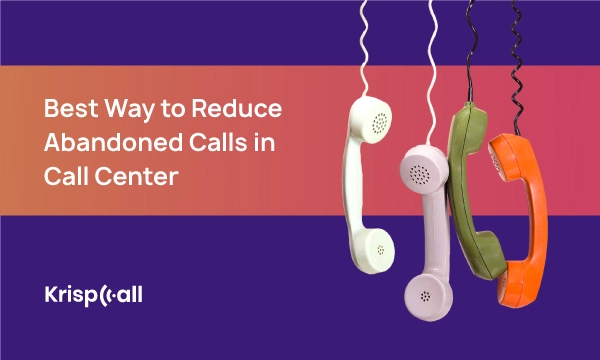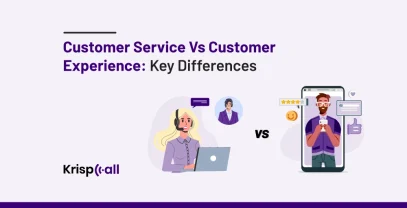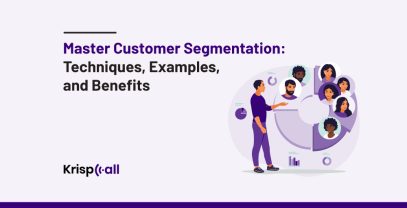When your call center experiences many abandoned calls, it means you’re missing a lot of opportunities to ensure excellent customer service. Whatever the reason for the abandoned call, the fact is that the customer who needed to reach your organization didn’t receive it, and that doesn’t bode well for success at your organization. So reducing the call abandonment rate is really crucial for business growth. And in this article, we will tell be discussing how to reduce abandoned calls in a call center in 2024.
Understanding Abandoned Calls & Call Abandonment Rate
First, let’s know what the call abandonment rate is and why it matters so much. A call abandonment rate is the number of abandoned calls divided by the total number of calls received in a day or particular period of time. It is usually expressed as a percentage.
It is useful to understand the significance of this metric when evaluating the performance of your company. When the caller hangs up before speaking to the agent, it is known as a call abandonment or abandoned call.
Any call center will experience call abandonment at some point. That doesn’t mean you should overlook it. Instead, you should do your best to keep the abandonment rate as low as possible.
A call abandonment rate between 5% and 8% is considered the industry standard at call centers. However, the number can increase during extraordinary circumstances. According to recent studies, one out of five mobile phone calls ends in an abandoned call.
Specifically, between 2019 and 2020, average abandonment rates increased from 8.53% to 8.93% due to long call queues and customer questions related to the COVID-19 outbreak.
Also Read: Things to consider while running a cloud call center
Reasons why customers abandon calls
In most cases, customers abandon calls because they are frustrated with your call center. Whatever the reasons be, understanding each of them is the first step to reducing abandoned calls at call centers.
1. Customers waiting in the queue without explanation
Everyone hates waiting. And the worst part of it is to keep waiting without any apparent cause.
Since the customers are always keen on getting their urgent matters solved, long waiting periods can create frustration in them. This sense of frustration is further aggravated when there is no explanation for the unnatural delay. And the customers will naturally lose patience, become more annoyed and eventually hang up if their calls are not addressed on time.
2. Customers have nothing to do while waiting
Even if the caller has time on their hands, they might abandon the call out of sheer boredom or because they were distracted by some other task. Just keep yourself in their shoes and think what you would do if you had to keep waiting inexplicably. Customers don’t know what’s going on the other side, and they have nothing to do to keep themselves engaged either.
3. Customers don’t have the option to call back or leave a voicemail
Voicemail and callback requests are excellent methods to encourage customers to peruse different options whenever the agents are busy. It is not uncommon for customers to have difficult schedules.
It is utterly annoying to wait on hold for an extended period of time. That’s more so when you are pressed for time with so many tasks to complete. If the customers have no other choice than to call and if the lines are busy at the exact moment, they will, without a doubt, hang up the phone. And that eventually increases the call abandonment rate.
Also Read: Top Call Center Metrics and KPIs to Measure Your Agent’s Productivity
KPIs that contribute to a high call abandonment rate
1. Average response time
One of the key metrics in your call center that sets you apart is response time. Customer service should be able to respond in 30 seconds, depending on the type of issue and the severity of it. Some companies, however, admit to taking twice that long.
2. Occupancy rate
It is an indicator of the number of on-duty agents at any time, along with the number of completed calls and what has happened after the call has been made.
3. After-call work
The amount of time spent on after-call work depends on how well an agent’s software integrates with their CRM and productivity applications. A simple, intuitive interface reduces after-call work to allow agents to return to the phone quickly without losing the quality of information.
4. Customer satisfaction
A satisfied client is one who does not complain. While measuring customer satisfaction seems as easy as that, it actually isn’t in reality. In order to set high standards, a high-quality call center software would examine how customers have behaved in the past, how often they call, and other issues.
5. First-call resolution
Resolving problems as soon as possible increases customer loyalty and satisfaction. The more time it takes to solve the issue, the higher will be the abandonment rate. It is recommended that different sectors have different baselines for first-call resolution. After all, Making a purchase or setting up an appointment is much more challenging than managing a complex financial transaction.
How to reduce abandoned calls in call center in 2024?
Any number of abandoned calls is bad for business and customer loyalty. Reducing the number of abandoned calls and keeping your call abandonment rate low helps overall customer satisfaction and means your organization is engaging with more customers and doing it more efficiently. So, what can you do to reduce abandoned calls in your call center?
This problem can be solved in a number of ways. Adding more people to your call center is the easiest solution, but it’s not the best solution for every situation. Here are some approaches to explore:
1. Customize the On-hold music and welcome message
Make sure your greeting message is lively. Create something people will love to listen to or give them information that they would like to hear. Similarly, research has shown that a majority of customers would like to listen to music while waiting.
Also, pay attention to on-hold messages. People don’t like to be informed every 30 seconds how long they will have to wait in a line if they have to wait 10 minutes or longer, and repeated phrases will do nothing but further add to the frustration.
Similarly, don’t stick to the same On-hold music and messaging for a longer period of time. Try replacing them with the information customers need to know, such as account information or product updates, etc.
2. Increase your ring time
Increasing ring time helps to buy more time for your call center representatives to handle earlier customers. Increasing the ring time before patching your IVR calls may be more effective than sending callers directly. Here is the psychology behind this – It’s normal for customers to wait through several rings before others pick up the phone.
In fact, people are accustomed to 20 second wait time before the phone goes to voicemail. And most people accept this as normal without a question. Therefore, try increasing your ring time slightly.
This may seem like a small change, but given that most calls are abandoned within the first minute, it’s worth trying to make that process as seamless as possible for customers.
3. Train your agents
A little investment in training and education can have a big impact on your agents and customers. Training modules, classes, and guides for call center agents can enhance an agent’s confidence in answering the phone, increases productivity, and improve the overall customer experience.
Invest in call center training and provide your agents with all the necessary tools along with the standard of etiquette. A reliable call center software means keeping your agents in the loop and conducting calls seamlessly. The entire call process can be streamlined to reach customer satisfaction quickly by training and equipping your staff.
4. Announce estimated wait time
A caller who is left on hold without indicating how long they’ll be waiting is more likely to become frustrated and abandon the call. Therefore, it’s important to be clear with customers and to define their expectations. This can be achieved by informing the customer of the estimated waiting time.
In cases where hold times are an issue, try providing customers with a message in Interactive Voice Response (IVR) explaining the expected wait time or indicating high volume periods. By doing this, they know how long they should be on hold before they can speak with someone.
5. Offer voicemail and automatic callback options
There are some customers who simply don’t have the patience or the time to wait very long. From having a meeting in the middle of a call to being on another call, customers can’t wait on hold for many reasons. Rather they will gladly choose options to leave a voicemail or take a call back.
Offering voicemail and automatic callback options in the event of high waiting times demonstrates your respect for customers’ time and attendance. On top of that, customers will have more freedom to choose these alternatives and can better manage their time. In the meantime, agents can handle a higher call volume, and you can reduce the number of abandoned calls in your call center.
6. Schedule according to to call volume
To ensure you’re fully staffed during peak hours, days, and seasons, you need to keep track of peak hours, days, and seasons. The more you are familiar with the call volume pattern, the lower the call abandonment rate you can make. With the advancement of CRM software, it is easily possible to monitor your call volume at hourly, daily, weekly, and monthly intervals.
With this data, you can predict peak hours in your call center and staff it accordingly. By doing so, you can always ensure that there will be a sufficient number of agents available to handle customer calls. You can also plan breaks and lunches based on the call volume to prevent queues from stacking up out of control and causing the call abandonment rate to spike.
7. Reduce Average Handle Time (AHT)
Average Handle Time (AHT) is one of those metrics used to measure the average duration of one transaction. That means this time includes the moment that the customer begins the interaction and any other related tasks during the conversation. One way to reduce the call abandonment rate is to focus on average handle time.
Just imagine your agents have limited time and spending too much time on one interaction means that agents can’t help other customers on hold. But what if you try reducing the average talk time on each call while still ensuring a good overall customer experience? In this way, agents can move quicker through the queue to the next waiting customer when they spend less time with a customer.
8. Offer self-service options
Offering self-service options is an easy and effective way to reduce abandoned calls and bring high satisfaction levels, even during peak hours. Customers don’t need to wait for the information they can obtain from your company’s website or IVR menu. The only thing it can do is frustrate them.
So, make sure the self-service options include the most accurate information about your products or services, as this will improve the quality of customer service. It will also increase your agents’ success rates, reduce abandonment rates significantly, and improve call center metrics.
Conclusion
The number of abandoned calls indicates that your customers aren’t receiving the level of service they expect – they could become dissatisfied or abandon you completely. Implementing these strategies is beneficial if your organization has high abandonment rates. Through them, more customers can be connected with your agents and enjoy an efficient and effective experience.
Need the right technology? KrispCall is efficient call center software that offers you a plethora of useful cloud telephony features to reduce abandoned calls. KrispCall helps you build a call center experience by providing an accurate and effective response to every call and eventually building high customer satisfaction.





